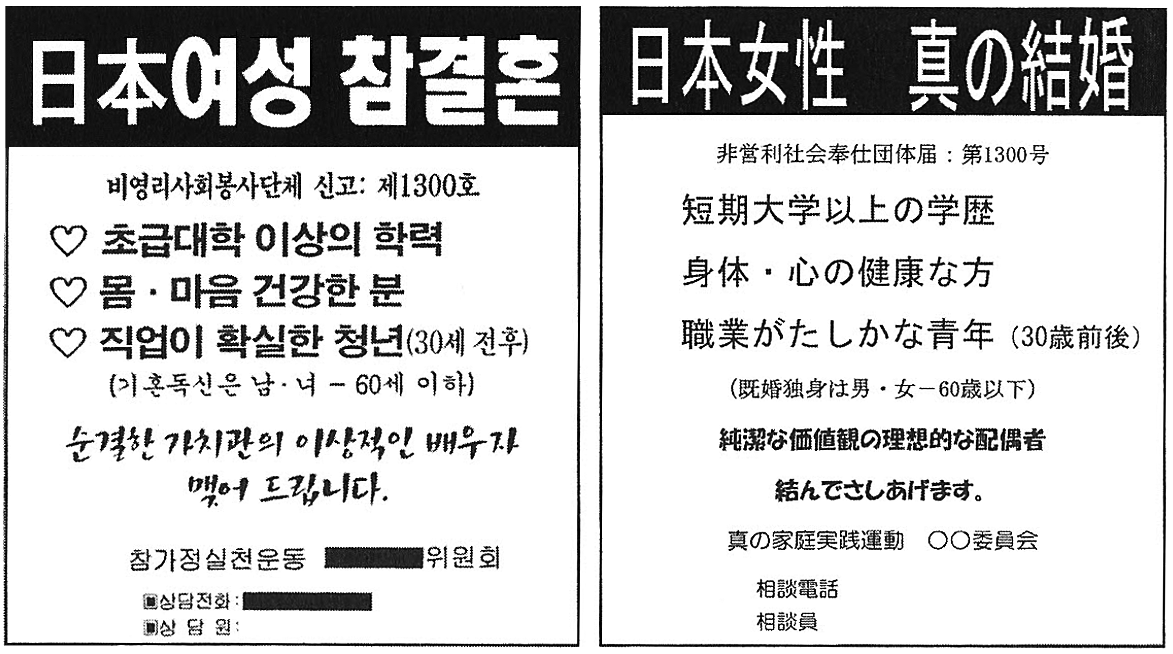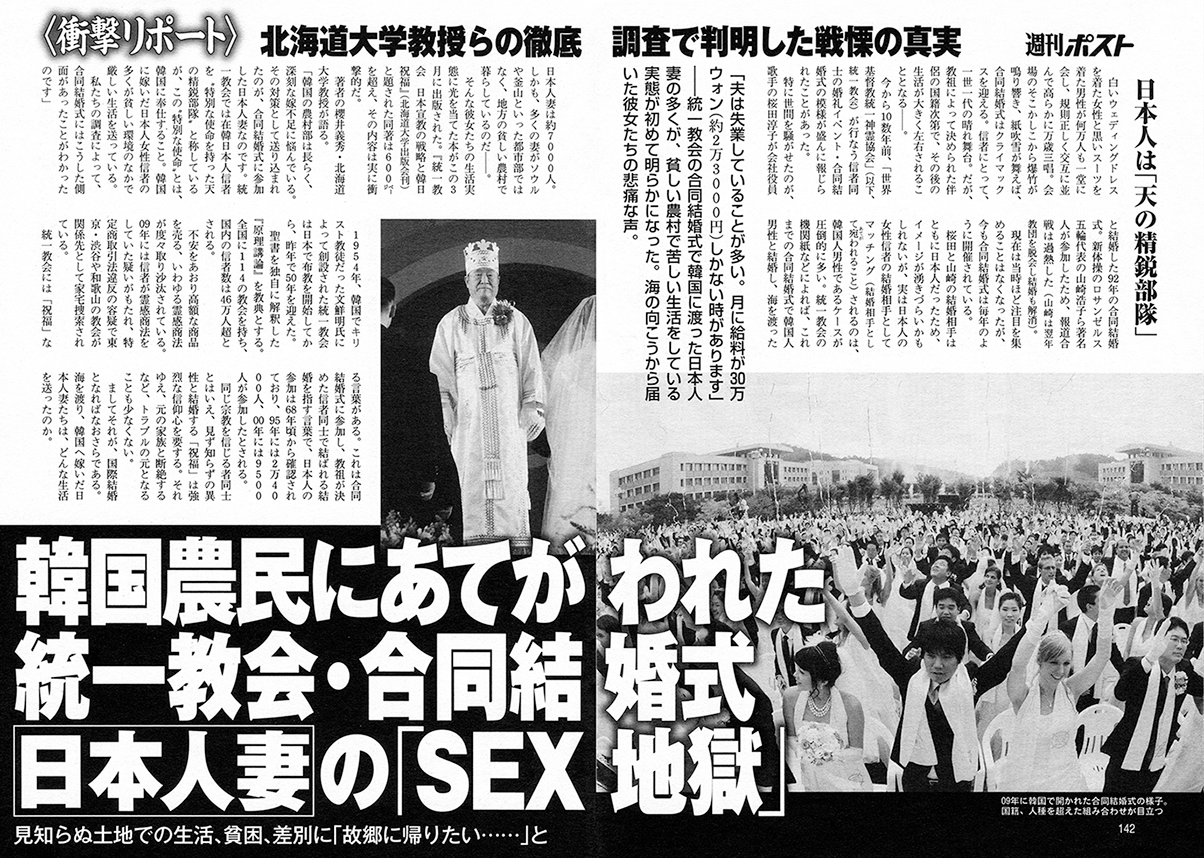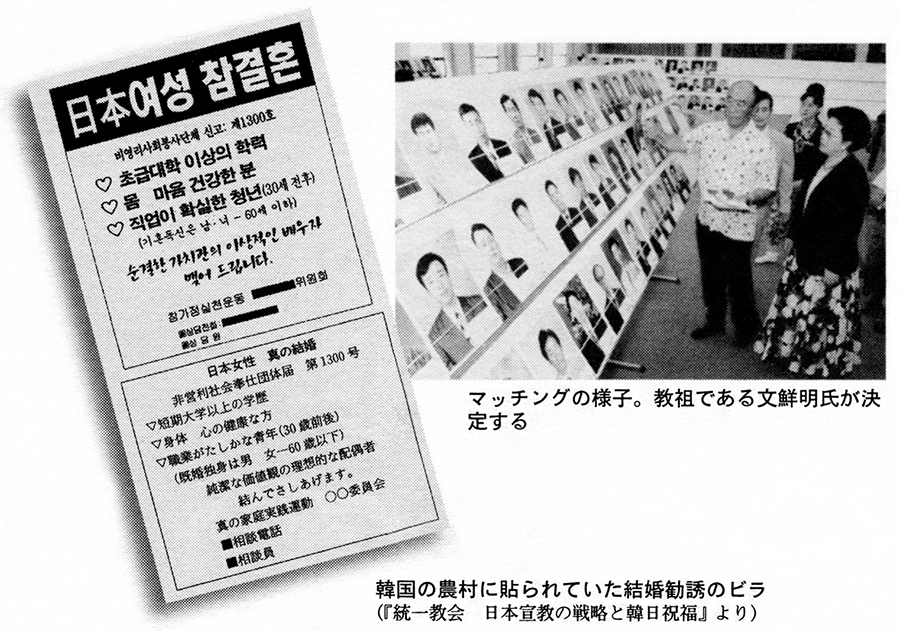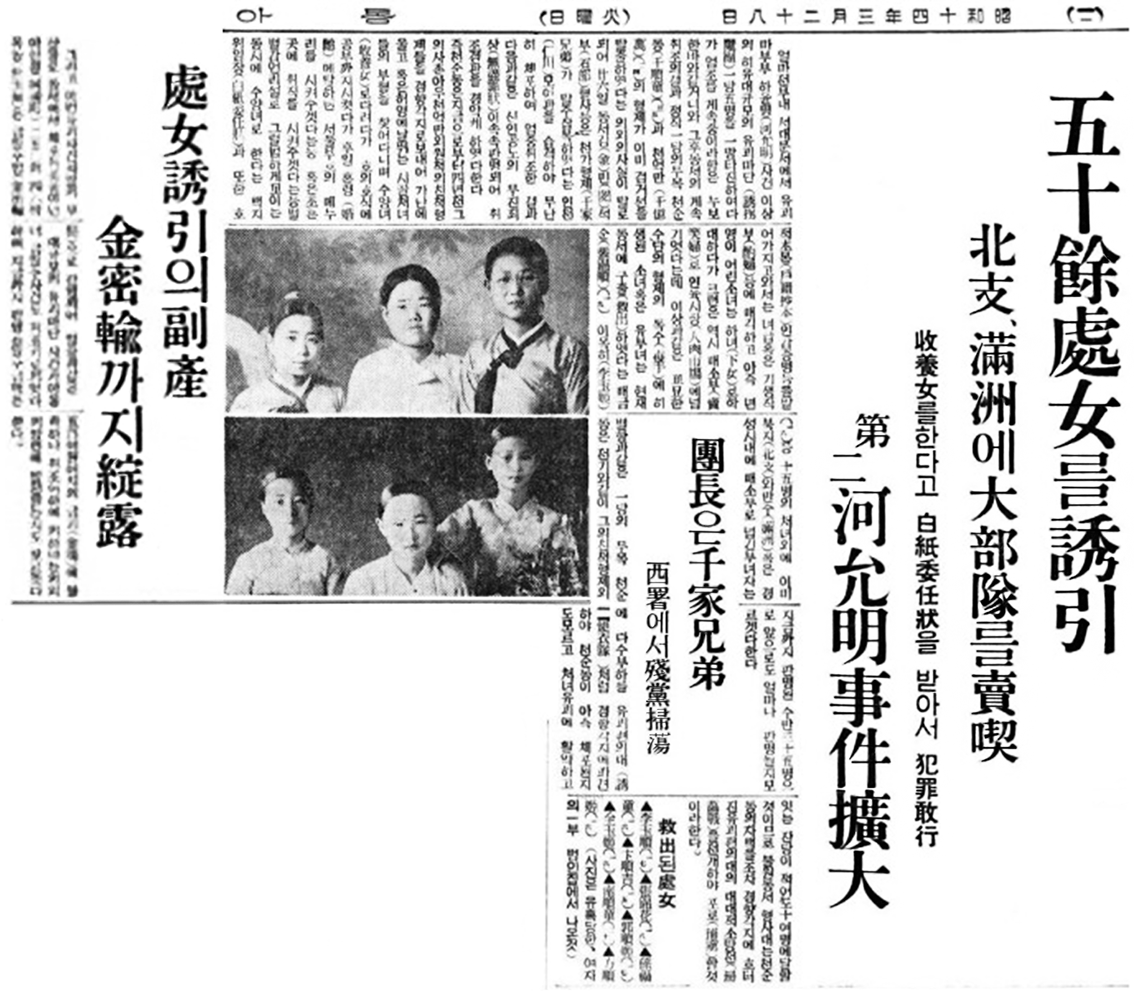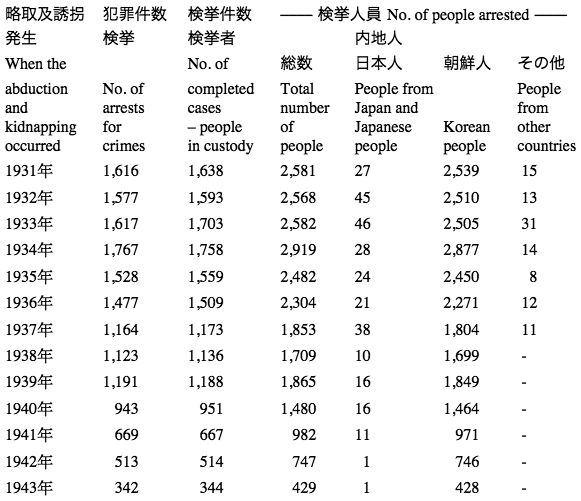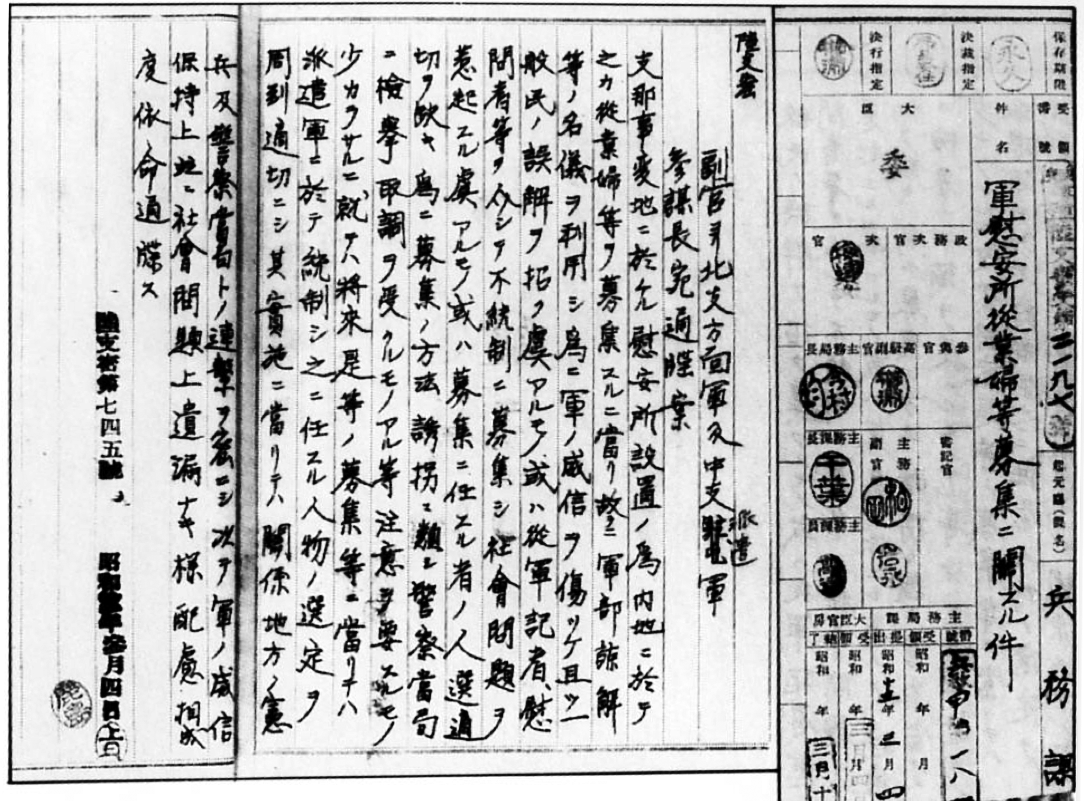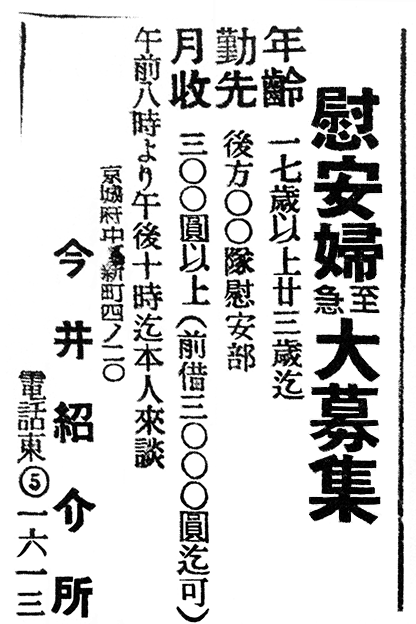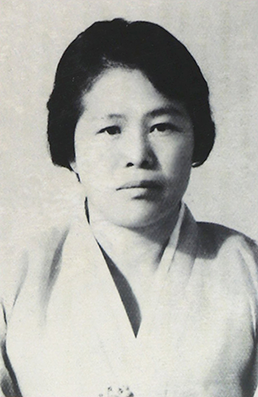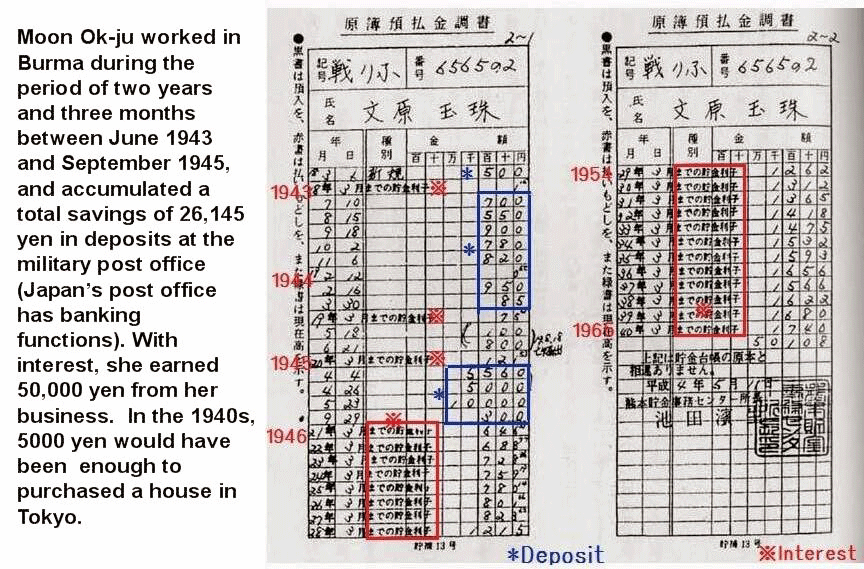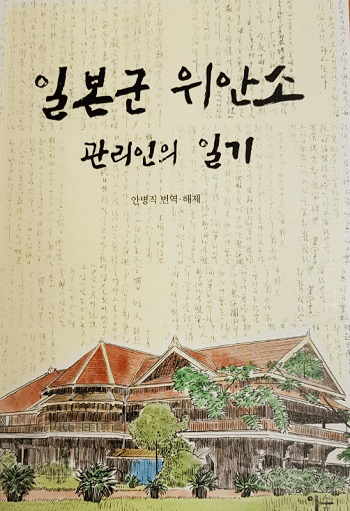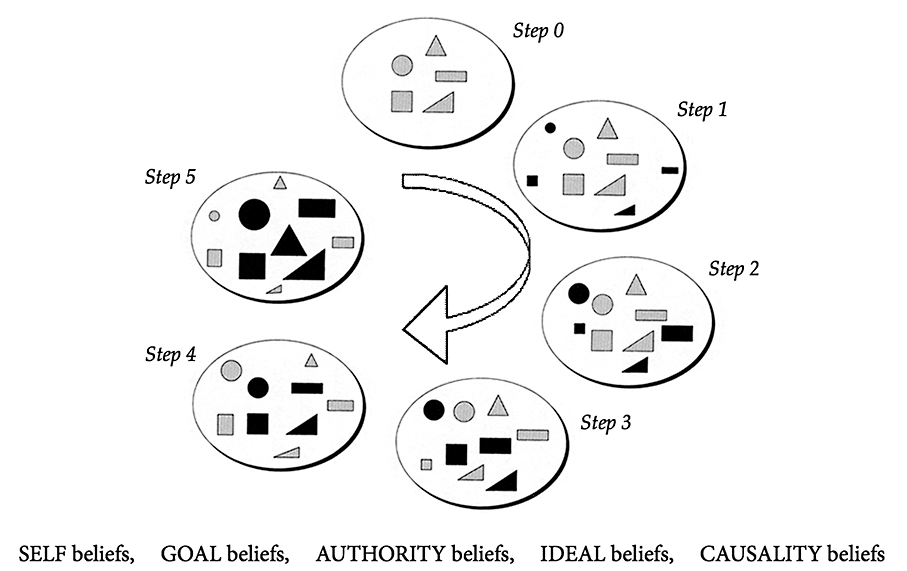A 20-year-old woman was recruited by the Moon church in Japan, and was then sold to an older Korean farmer in an “apology marriage”. He was not a Unification Church or FFWPU member.
Updated March 3, 2021

▲ Seoul, South Korea, August 14, 2012: Japanese members of the Unification Church/FFWPU bow as an act of apology for the wartime Korean sex slavery conducted by the Japanese military.
Liberation Day in Korea falls on August 15. It is the anniversary celebration of Korea’s liberation from Japanese colonial rule in 1945. This rally was held the day before.
PLEASE RETURN MY SISTER WHO IS IN SOUTH KOREA
1. Ms. Nameless Posted: 01/10/25 ID:FFmOrZXZ
I want to write about my experience here as my serious warning to all Japanese women. Please note, everything I write about from this point is true!!
My elder sister, who was bright and pretty, got involved with a Korean woman and developed an interest in the country of South Korea.
Then she was taken away to South Korea where she became a virtual slave.
You might say “You are so silly!” But this story is true. The tricks used are surprisingly clever, and thousands of Japanese women have already been taken away to South Korea through this scheme.
Now, I want to reveal their dirty tricks. I want to bring this to the attention of all Japanese women, so they can be careful. And again I want to say that this is based on my actual experience. I would like to sincerely ask you not to interfere with the warning I am going to put on this website.
It all started three years ago.
“I met some Korean people and we became friends.” It all began with these words from my sister. She was in her junior year at university when a female Korean student sat next to her on a bench on campus and started to talk to her. The two of them soon became close friends. I also met that Korean student several times and I had a good impression of her. She was courteous and seemed to be a nice person. I heard that she was a member of a peace organization.
2. Now I really regret that I was not more aware of what was going on at that time. My sister had begun to attend “Culture Classes” given by the peace organization that she had been introduced to by the Korean student. According to my sister, the class was “to learn about peace”. In the class she watched many videos and then listened to lectures.
Although the name of the class was “learning about peace”, the contents were only about “how the Japanese tormented the Koreans”. After watching such videos for hours and hours, they then listened to lecturers from the organization – and the topic was always “How the Japanese people have never compensated for their crimes and always speak irresponsibly”.
One day my sister had a pale face. She explained to me “the Japanese army forced 150 Korean comfort women to stand in a line and they cut off their heads one by one. Then they made a soup from the severed heads – and forced other comfort women to eat this soup ……”
I was shocked by the story, but at the same time it sounded “exaggerated” to me – so I got suspicious.
While continuing to attend the culture classes, my sister’s attitude gradually changed. She began to repeatedly say, with desperate expressions on her face, “I’m so ashamed that I was born Japanese,” or “the Japanese people must make amends to the Korean people right now,” or “the current Japanese prosperity is founded on the sacrifices the Korean people [were forced to make during the Japanese occupation of their country].” She completely forgot about her university studies and started to study the Korean language.
▲ A poster promoting Japanese women available for marriage. It was affixed in a South Korean farming village. Marriages were then officiated by Sun Myung Moon in a mass marriage held in Seoul.
Translation of the poster (Korean on the left and Japanese on the right):
True Marriage to a Japanese Woman
Nonprofit community service organization: Registration No. 1300
♥ Junior college or higher educational background
♥ Healthy body and mind
♥ For a young man who has stable employment (around 30 years old)
(Previously married men and women, now single, must be aged 60 or less)
Ideal spouse with a chaste sense of values.
We will match you up.
True Family Practice in conjunction with ◯◯ Committee
Consultation phone
Counselor / Consultation Staff
3. Then my sister said, “I want to go to Korea to apologize to the Korean people in the Korean language”.
I did not think it was necessary for her to go, but on the other hand I thought it was good to make international friends. I didn’t take it seriously enough.
One day, my sister told me that I should also study the Korean language. I asked her why. She answered, “The Korean language will become the global language and is the most excellent language in all of human history”.
On hearing this I became more suspicious. So I secretly sneaked into my sister’s room while she was away. There I found books entitled “The Divine Principle” and “Apostate” and some brochures. I started reading them and was appalled at the contents. One item said, “Japan is a country ruled by the devil. It tormented South Korea which should be the country to lead the world,” another said, “Japan is the country representing Eve, and Korea is the Adam country. Therefore it is Japan’s obligation to work to serve Korea [to reverse Eve’s mistake in the Garden of Eden].” “After the unification of North and South Korea, the country will become the center of Asia and will then rule the world”. The literature was full of such crazy things!
I asked my university tutor about the information which had given me such an uneasy feeling. He told me, “Well, that is the Unification Church.” Then I researched into the Unification Church and discussed it with my parents. We all tried to convince my sister to withdraw from this Church. But it was too late. She took a hard line and decided to quit university and insisted on going to South Korea straight away.
We were desperate. We tried to stop her, but she swore at us angrily saying, “You people are all devils who want to insult the Messiah and South Korea which will lead the world!” We were horrified at the change in her. I cried, together with my parents.
4. Suddenly, my sister decided to participate in a mass wedding ceremony in Seoul and so finally she left our home.
I protested to the Korean student who had invited my sister to their meetings. This student completely changed from her previously polite demeanor. I asked her “You are a member of the Unification Church, aren’t you?” But she acted as if she didn’t know. “Eh? What is that?” she replied.
I said, “The founder of Unification Church is Sun Myung Moon; he’s really weird, isn’t he?”
My comment made her so upset.
“What did you say?!” She yelled like mad, spitting out her words, her face red with anger.
Although she had hidden this fact, she was indeed a member of the Unification Church!
My family was so sad, we all cried for a while after my sister left home. We all worried about her circumstances.
Soon my sister contacted us to say that she had got married to a Korean man and was living in countryside. For a time we felt relieved. Then she began to send frequent letters. She wrote “Please send money”, and “send electrical goods” and other things. It seemed that her Korean “relatives” in the countryside demanded that she get money and goods from our family for their sake. My parents felt that they had no choice but to continue to send money and goods as requested.
We worried what sort of life my sister had in Korea. I decided to go to there to see her and find out her situation. It was dangerous for me to go alone, so we had to make an effort to find an appropriate person to be my interpreter and bodyguard. We hired Mr. A., who was a Japanese exchange student living in Seoul.
Thousands of Japanese brides from the Unification Church were allotted to South Korean farmers.
週刊ポスト No.20 2010(H22) 年6月4日号 [雑誌]
Shukan Post No.20 2010 (H22) June 4 issue [magazine]
〈衝撃リポート〉〈Shocking Report〉
韓国農民にあてがわれた統一教会・合同結婚式日本人妻の「SEX地獄」
見知らぬ土地での生活、貧困、差別に「故郷に帰りたい……」と
▲ “SEX Hell” of the Japanese wives who were allocated to Korean farmers in a Unification Church mass wedding ceremony
living in an unfamiliar land; poverty; discrimination “I want to return home …”
北海道大学教授らの徹底調査で判明した戦慄の真実
The striking reality discovered through an in-depth investigation by professors from Hokkaido University
▲ The matching – Mr. Sun Myung Moon decides couples. [Hak Ja Han is standing beside him.]
On the left is a poster promoting Japanese women for marriage. It was found shortly before a Unification Church “Korea-Japan” mass wedding which was held in Seoul. The Korean men had to pay $thousands to get a Japanese bride. It was often a family investment, so the women’s passports were taken, and other measures, to prevent them from escaping. A United Nations report highlighted the cultural problems of these marriages. A substantial number of which ended in divorce. One main reason divorces were granted when requested by the women, was the fact of the FFWPU coercion the Japanese women had experienced to offer themselves in “apology to Korea marriages”. LINK
5. Mr. A took me to the address which was written in my sister’s letters. It was in the Korean countryside.
The place was totally different compared to the general countryside of Japan. It was a pre-modern farm in a village with unpaved roads. We found my sister in one of the poor village houses. My sister seemed glad that I had come to visit her. Her husband was the son and heir of a farming family. He was an ugly and uneducated countryman. He seemed to be over 40 years old although my sister was in her early 20s.
Mr. A and I talked together with the poor family for a while.
I thought it was impolite of me to do so, but I gently challenged their marriage, and asked my sister to return to Japan.
Suddenly the interpreter became pale. He explained that my sister’s husband said, “I paid money!” and he continued with a vulgar smile “It was a good deal, ’cause this Jap girl has got a nice body.”
This made me so angry. I really wanted to kill him – but in this situation, I had to silently endure his comments for the sake of my sister’s safety. My sister also said, “the Japanese people must make amends to the Korean people.” She said she was working from morning to night. Listening to the family’s conversation, Mr. A whispered in my ear, “it seems she is almost a slave”.
6. There was nothing I could do for her, so I returned to Japan. On the way to the Seoul airport, Mr. A explained many things to me. For example, he said there was a strange group of Japanese women in Seoul – all Unification Church members – who worked all day from early in the morning. Those women often joined demonstrations and performances against Japan, or were perhaps forced to join in such activities.
In addition, when I spoke about the Korean comfort women, he said he had heard from an old Korean man, who had himself experienced the Japanese colonial era. The man had said, “the coercion story [of forced recruitment] is complete fiction”.
According to the old man, the truth was that poor families in rural areas sold their daughters to Korean prostitution brokers. It was a common solution in the Asian region, including in Japan, for such poor people to get out of deep poverty. “It is fiction that the Japanese Army arranged trucks to kidnap girls. Nobody ever saw such a spectacle and I never heard such rumors at that time”, the old man told Mr. A.
I then said to him “so the comfort women stories must have been created by somebody for a certain purpose.” He caught my drift that the Unification Church was using the comfort women stories. “I know a person who is close to a lawyer, Mr. Takagi, who is responsible for litigation in wartime comfort women cases. I will contact him to see if he knows something about this.”
7. I returned home with a feeling of deep frustration. I could not speak honestly to my parents about my sister’s situation. I had the impression that my sister had been sold to Korea as collateral, as a servant.
A while later, my sister suddenly informed us that one of her “relatives” was going to visit Japan and she wanted us to take care of him. My parents and I really disliked the idea, but felt we could not refuse.
A crude beggar-like young man arrived.
The Korean man had a featureless face with narrow eyes, just like pen lines. At first he seemed emotionless, but soon violent mood swings emerged. He would yell and his face then became the color of a boiled octopus. Especially during meal times he would sit at the table in a very rude manner. He ate his food making horrible noises. Not only that, but he complained saying “Why you don’t serve kimchi, huh?!”, “So bland taste!!” and so on.
Needless to say I really hated this Korean guy.
One day, he yelled at my mother. “The sauce for dipping the tempura is too bland! You’re stingy! Are you trying to belittle your precious guest?!”
I was reaching to the limit of my patience. I seriously thought about putting something like pesticide into his drink.
I felt he was always looking at me in a strange way.
One night, the man sneaked into my room and tried to rape me, covering my mouth with his hand. I screamed and scratched his face. He beat me with all his strength.
This made my father furious and he drove the man out of our house. Finally I could be reassured.
8. One day Mr. A., the student who was in Seoul, sent me some surprising information. The following is a summary of what he sent.
What I should explain first is that it was an organization called the “Hundred Members Committee” who raised the “Comfort Women Issue” for the first time. The goal of this organization was to “obtain official apologies and compensation [from the Japanese government] for the Korean people”. Some Korean members of this organization, and Japanese housewives, went to South Korea “to search for victims” suitable for starting a lawsuit. Kim Hak-soon, who was the “courageous first woman to come forward as a victim of the sex-slave system”, was just a Korean prostitute who made a lot of money from her prostitution business with Japanese soldiers. But the “Hundred Members Committee” searched for such kinds of prostitutes and had them appeal to the Japanese government. Then they started international propaganda about the issue.
Now, what sort of organization is the “Hundred Members Committee”? In fact, this committee was created by the “Asian Women’s Federation for Peace” and that is a secondary organization of the Unification Church! Besides, Kenichi Takagi, the lawyer who supported the prostitute lawsuit, and the Japanese housewives who went to Korea to search for “victims” are also all members of the Unification Church. (Of course they all denied being church members. This is the modus operandi of the Unification Church. Members are instructed to say “We are different” when they are asked “Are you members of the Unification Church?”) Their actions are based on their belief in the teachings of the Unification Church that “Japan is a country of the devil and must therefore act to make restitution for their crimes which plagued Korea, the country of the Messiah”.
9. After the rapprochement between Sun Myung Moon and Kim Il-Sung in 1992, the General Association of Korean Residents in Japan came to be involved in activities concerning the comfort women issue, and many North Korean “fake comfort women” appeared one after another. They circulated stories to the international community, such as “the Japanese soldiers cut off the comfort women’s heads with swords, and made soup with the heads which they then made us drink”.
Then what is the reason why the Unification Church fabricated the “sex slave issue”? The reasons are complex.
First, they wanted to diminish the credibility of Japan and the Japanese people, so that they can make the Japanese government pay compensation to Korea, and give advantage and political status to Zainichi Koreans in Japan.
_____________
Note: Zainichi Koreans, also often known as Zainichi for short, (or Chōsen-jin) comprise ethnic Koreans who have permanent residency status in Japan, or who have become Japanese citizens, and whose immigration to Japan originated before 1945, from Chōsen (the old, undivided Korea), or who are descendents of those immigrants. They are a distinct group compared to South Korean nationals who have travelled to Japan for the sole purpose of employment or study.
More details on Wikipedia: Zainichi
_____________
Secondly, they wanted to brainwash more Japanese women to set them up for “human trafficking” [as their duty or responsibility]. In the Japanese women’s minds they planted the consciousness that the guilt [or shame of Japan] should be expiated, or atoned for. These Japanese women believed that being in the same situation as Korean comfort women could be a way to personally go through suffering to compensate [for the suffering endured by Korean comfort women during the Japanese colonial period.]
According to Mr. A, thousands of Japanese women had already been tricked this way, like my sister. Especially in countryside of Korea there is a high demand for these women. The Unification Church groomed the women for human trafficking to be collateral!
When I heard this story I was stunned.
I also heard from another person who was with Mr. A, that 辛淑玉 Tsura Yoshi-dama [Shin Sug-ok], had a relationship with the Unification Church and she delivered lectures to Unification Church-affiliated organizations.
[ 辛淑玉、シン スゴ、신숙옥、女性、1959年1月16日- . とは、東京都生まれの実業家。のりこえねっと (ヘイトスピーチとレイシズムを乗り越える国際ネットワーク)共同代表、シューレ大学アドバイザー。東京都立第一商業高等学校卒業。在日韓国人3世。LINK ]
[ 辛淑玉, Shin Sug-ok, worked for the International Network to Overcome Hate Speech and Racism. She is a third generation Zainichi Korean. ]
I came to think I could not trust Zainichi Koreans.
Apparently the Unification Church believers, the General Association of Korean Residents, and human rights campaigners in Japan were all in one crony gang.
The reality is that they are despicable people who continue activities to prepare and induce Japanese women to become the slaves of Koreans – all behind a mask of justice!
10. Currently, a lot of Japanese women are being fooled by this Korean propaganda and support their activities. This it is totally wrong because it just helps the crimes of the Unification Church. I will say it again and again, so many Japanese women are sold to Korea as a “commodity” for human trafficking by the Unification Church, just like my sister. If you doubt my story, please take action and research what miserable lives those Japanese women have in Korea. You will find out those women are virtually enslaved. I don’t understand why the Japanese mass media do not report these harrowing tales. Why do the the so-called quality papers like Asashi shimbun, Mainichi shimbun or Yomiuri shimbun not explain to the public that right now such women are being trafficked ? Why!?
I simply want to ask why Japanese TV stations do not report the fact that Japanese women are victims like this? Why is this so?
Right at this moment, many Japanese women are brainwashed by this bad Korean religion and sold to Korea to be enslaved for their whole lives.
I want my sister back!
11. Now, I will finish my story about the miserable experience of my family.
I think our experience is hard to believe for most Japanese women, but it is true.
I think all Japanese women need to know the existence of this terrifying trap that leads Japanese women to such miserable situations. That is why I put this series of messages on the internet.
However, I do think most of the Zainichi Koreans in Japan, and the South Korean people, are good people. So please do not have prejudice based on ethnicity against all Korean society. But it is a fact that there are some crazy people who have done horrible, malicious and wicked things to the Japanese people, and they continue to do so. And they have no scruples about what they are doing. It is also a fact that such things have been neglected or ignored.
[Because there have been many instances of the abuse of foreign wives, the South Korean government introduced the screening of men wishing to marry them. There has been a gender imbalance in South Korea due to some couples having a preference for sons – they are more valued in the Korean neo-confucian mindset. In 2017 there were about a million fewer women than men in the 15-50 age group. This is one of the reasons for an increased demand for foreign wives, and it can present good business opportunities.]
Maybe there are some people who do not want to believe my story.
I don’t want to be hurt by heartless responses like “show the evidence!” or “don’t make up such a story!” So I will never come back here again.
Each person is free to believe or not. I cannot blame people who do not believe my experience. It has not been broadcast or well publicized by the mass media.
But anyway, let me insist again, the whole of my story is true! It is factual!!
Notes
Sun Myung Moon was the founder of the Unification Church [which was known as the Family Federation for World Peace for twenty years]. The religion is a South Korean based organization. [Moon claimed to be an] activist in the Korean independence movement during Japan’s annexation of the Korean Peninsula. After the independence of Korea, he established the International Federation for Victory Over Communism against North Korea. [Moon died in September 2012.]
Kim Il Sung was the former leader of the socialist nation, the Democratic Republic of Korea (North Korea). He was well known for his Red Terror with continuous blood purges to maintain his political power. Kim died in 1994.
There were Korean Comfort Women used by the Japanese military. There are testimonies and photographs, and there is a lot of evidence. However, it seems to be true that most of the recruitment of the women was done by Koreans, and there were even notices in Korean newspapers for Comfort Women.
It seems there are also fake Comfort Women seeking compensation. [There is clear documentation that Korean Comfort Women changed their testimonies over the years – and there is evidence that some were coerced to do that under threat of losing their accommodation.]
Japanese police rescued women trafficked by Koreans (1930-1945)
There are a huge number of incidents of job fraud, forced labor, human trafficking, and kidnapping.
The perpetrators were always Koreans, and they also made Japanese women the target of the crime. It was the Japanese police who arrested the Korean traffickers and rescued the women.
This website has a small sample of the many newspaper reports from the era:
https://gall.dcinside.com/board/view/?id=history&no=1283822
Dong-A Ilbo March 28, 1939 1939.03.28 동아일보
50여 처녀가 조선인 인신매매단에 걸려서 북지, 만주에 창기로 팔림.
일본경찰이 구해줌.
Over 50 women were deceived by a Korean trafficker (Bae Jang-eon 배장언) and sent to Northern China & Manchuria. He was arrested and the women were rescued by the Japanese police.
五十餘 處女를誘引
北支滿洲에大部隊 를賣喫
收養女를한다고 白砥委任狀을 받아서 犯罪敢行
第⼆河允明事仵擴大
五十餘(오십여)處女(처녀)를 誘引(유인)
北支(북시), 滿洲(만주)에 大部隊(대부대)를 賣喫(매끽)
收養女(수양녀)를 한다고 白紙委任狀(백지위임장)을 받아서 犯罪敢行(범죄감행)
第二(제이) 河允明(하윤명) 事件(사건) 擴大(확대)
處女誘引의副産
金密輸까지綻露
Virgins enticed to a place where they could make money
– but it was exposed as smuggling for prostitution.
Thousands of Korean men and women tricked, kidnapped or forcibly abducted Korean girls to be ‘comfort women’.
朝鮮半島で朝鮮人女性を騙したり誘拐したりして強制連行したのはほとんど朝鮮人ですから
Statistical Yearbook of the Governor-General of Korea, from 1931
朝鮮総督府統計年報. 昭和 13年
This report was published in March 1944.
Abduction and Kidnapping 略取及誘拐
Number of crimes where arrests were made 犯罪件数検挙
Number of completed or cleared cases, people in custody 検挙件数 検挙者
Crime of abduction and kidnapping 略取及び誘拐の罪
https://mainichi.jp/english/articles/20160610/p2a/00m/0na/018000c
According to testimonies from former “comfort women,” we know that there were many cases of women being defrauded into becoming “comfort women” after they were told they’d be given lucrative work. The sexism ingrained in society and the poverty faced by the Korean peninsula under Japanese colonial rule made it particularly easy to commit such employment fraud.
Dong-A Ilbo March 7, 1935 1935.03.07 동아일보
上海暗黑窟로轉落된
朝鮮女性⼆千餘名
娼妓舞女,女給으로體面損傷
慘淡한生活對策漠然
중국 상해 암흑굴에 조선여성 2천여명. 이들 원정녀들 때문에 조선인의 체면이 손상됨.
그녀들의 참담한 생활에도 불구하고 대책이 막연.
왜냐하면 경제적 문제로 인한 자발적인 근로라서 대책을 세울 수 없음을 안타까워하는 내용.
About 2,000 Korean women work at brothels in the Shanghai slums.
Koreans lost face because of these Korean prostitutes who are working abroad. The measures to help them are vague in spite of their miserable lives. It is a shame, but because they are working voluntarily due to their economic problems, there is no solution.
(This article is about how regrettable it was that there was no way to plan any measures for the problem because the women were doing voluntary work due to their economic situation.)
Maeil Shinbo March 28, 1939 1939.03.28 매일신보
(Korean language newspaper, probably Seoul)
純眞한農村婦女
百餘名誘引賣喫
부자와四촌등세명이공모후수년을범행
西署에第⼆『河允明』事件
농촌처녀 유인해서 100 여명을 팔아먹음.
부자와 4촌이 가족친지 조선인 납치단임.
이걸 일본경찰이 검거해서 여성들을 구해줌.
The culprits lured girls from farming villages and sold 100 of them.
The Korean trafficking gang were all family relatives, a father, son and a cousin. The Japanese police arrested them and rescued the women.
The Japanese military were concerned about the criminal methods used by Korean “comfort women” recruiters and brokers.
A notice to Japanese military commanders in China concerning Comfort Women.
March 4, 1938
Title: “Matters regarding recruitment at military comfort station”
<Notification>
From: Assistant
To: Army Chief Generals of the troops in northern China and of the expeditionary force in central China
When brokers recruited comfort women for the establishment of brothels during Sino-Japanese war, there were more than a few infamous cases to which we need to pay attention: the case of some brokers using the authority of the Japanese military for their recruitment, as the result, they ruined the credibility of the Japanese military, which led to a misunderstanding of ordinary people, the case that some brokers used an unruly method of recruiting through embedded journalists and visitors, causing social problems, the case that some brokers were arrested and placed under investigation because their recruiting method was similar to kidnapping. From now, as regards the recruitment of comfort women, the expeditionary force must properly choose and control brokers who recruit comfort women. Also, it is necessary to cooperate with the military police and law enforcement authorities. To keep the prestige of Japanese military, and to consider social problems, take careful note without omission.
March 4, 1938
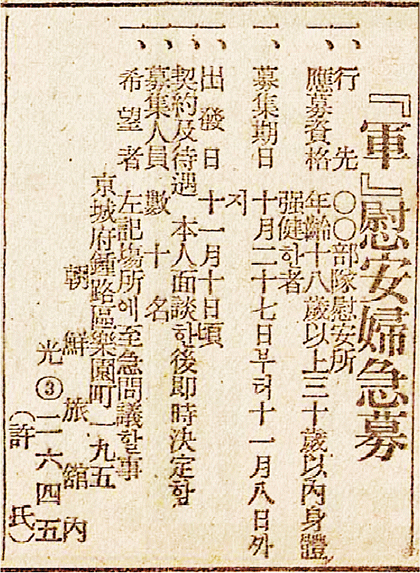
『毎日新報』1944年10月27日付
『軍』慰安婦急募
一、行 先 〇〇部隊慰安所
一、應募資格 年齢十八歳以上三十歳以内身體[体]強健한者
一、募集期日 十月二十七日부러十一月八日外지
一、出發[発]日 十一月十日頃
一、契約及待遇 本人面談한後即時決定함
一、募集人員数十名
一、希 望 者 左記場所에至急問議할事
京城府鍾路區楽園町一九五
朝鮮旅館内
光③二六四五
(許氏)
Maeil Shinbo published October 27, 1944
“Military” Comfort Women Urgent Recruitment
Destination: Troop Comfort Station (location not decided)
Employment Requirements: Age between 18 and 30; good physical health (robust body)
Recruitment period: From October 27 to November 8.
Departure date: Approximately November 10.
Contract and Remuneration: Decided immediately after interview with individual
Recruiting number: several dozen
Aspirants should make urgent contact at the following location:
Kyeongseong-bu, Jongro-gu, Akwon-jeong 195 [Seoul Prefecture]
Inside the Joseon Inn
Gwang (3) 2645 (Phone number)
[Ask for] Mr. Heo 허 (name of the Korean person in charge)
『京城日報』 “Keijo Nippo” 경성일보 Kyongsong Ilbo (Daily) newspaper.
The paper was published during Japanese colonial rule. At this time (1910–1945), Seoul was called Keijo (京城); (Korean: 경성; Gyeongseong or Kyongsong, literally meaning “Capital City” in Hanja.)
京城日報』(1944年7月26日付)
慰安婦 至急 大募集
Comfort Women Urgently Wanted – Large Recruitment
年齢 一七歳以上 二三歳迄
Age: From 17 to 23.
勤先 後方〇〇隊慰安部
Place of work: Troop comfort station behind the front-line
月収 三〇〇圓[円]以上(前借三〇〇〇圓[円]迄可)
Monthly income: more than 300 yen (advance borrowing of up to 3,000 yen allowed)
午前八時より午後十時迄本人来談
Individual client consultations from 8:00am to 10:00pm
京城府中* 新町四ノ二〇
Apply to: 4-20 Shinmachi, Keijo City [Seoul]
今井紹介所 Imai Agency (a private company)
電話東⑤一六一三 Telephone East: ⑤1613
These salary rates are huge. Women factory workers earned about 20-50 yen at this time.
Here is the bank savings passbook of Mun Ok-chu:
Moon Ok-ju worked in Burma during the period of two years and three months between June 1943 and September 1945. She accumulated total savings of 26,145 yen in deposits at the military post office (Japan’s post office has banking functions). With interest, she earned 50,000 yen from her business. In the 1940s, 5000 yen would have been enough to purchase a house in Tokyo.
The following is an English translation of excerpts from the memoir of former Korean comfort woman Mun Ok-chu
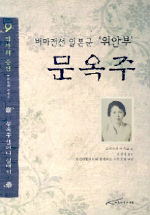
▲ 버마전선 일본군 위안부 문옥주 문옥주 할머니 일대기
역사의 증언 두번째 이야기
“Myself as a comfort woman for Tate Division deployed in Burma” by Mun Oku-chu
(In Mandalay, Burma)
Page 63
The soldiers and we had the same thoughts, that is, we must work hard for our emperor. The soldiers gave up their wives, children and their own lives. Knowing how they felt, I did my best to solace them by having conversation with them.
Page 68
I prayed for safety of Ichiro Yamada. After two or three of months, the troop unit to which Yamada belonged returned from the front. Yamada returned in good health. He immediately came to the comfort station. He said “I, private first class soldier Yamada, have just come back from the front.” Yamada gave a salute to me. We hugged in full of joy. Such a day was so special that the comfort station owner Matsumoto (a Korean from Daegu) closed business for the day. The comfort station was full of excitement, and we, comfort women, contributed 1 yen per woman to hold a big party for them.
Page 75
I saved a considerable amount of money from tips. So I asked a clerical staff whether or not I could have a saving account and put the money in the account. His reply was positive. I knew that all the soldiers put their earnings in the saving accounts in the field post office, so I decided to put my money in the saving account. I asked a soldier to make a personal seal and put 500 yen in the account. I got my savings passbook and found 500 yen written on the passbook. I became the owner of the savings passbook for the first time in my life. I worked in Daegu as a nanny and a street seller from the childhood but I remained poor no matter how hard I worked. I could not believe that I could have so much money in my saving account. A house in Daegu cost 1,000 yen at the time. I could let my mother have an easy life. I felt very happy and proud. The savings passbook became my treasure.
Page 98
Ichiro Yamada came to see me once a week and I was in a great mood on that day from the morning. But if he did not show up on his once a week holiday, I became so worried wondering if he was killed by the enemy that I could not work properly. He made me worry so much.
(In Rangoon, Burma)
Pages 106~107
I was able to have more freedom in Rangoon than before. Of course, not completely free but I could go out once a week or twice a month with permission from the Korean owner. It was fun to go shopping by rickshaw. I can’t forget the experience of shopping in a market in Rangoon. There were lots of jewelry shops because many jewels were produced in Burma, and ruby and jade were not expensive. One of my friends collected many jewels. I thought I should have a jewel myself, so I went and bought a diamond.
Page 107
I often went to see Japanese movies and Kabuki plays in which players came from the mainland Japan. I enjoyed watching players change costumes many times and male players portray women’s roles. I became a popular woman in Rangoon. There were a lot more officers in Rangoon than near the frontlines, so I was invited to many parties. I sang songs at parties and received lots of tips.
(In Saigon, Vietnam)
Pages 115~118
It was finally time to return home. I went to Saigon via Thailand. The ship was to depart from Saigon. Then Tsubame said “I had a nightmare in the morning about my mother vomiting blood. I am afraid that something unlucky will happen, so I will not return to Korea.” Hiroko, Kifa and Hifumi agreed with Tsubame saying “We will not go back to Korea, either.”
Page 120
When I went to a cabaret where Japanese military men hung out, navy pilots were there. Some of them asked me “Why are you still here?” I replied “I am still here because I don’t want to go home. I want to go back to Rangoon.”
Page 121
I put on a pair of high heels, a green coat and carried an alligator leather handbag. I swaggered about in a fashionable dress. No one could guess that I was a comfort woman. I felt so happy and proud.
(Back In Rangoon)
Page 123
A military man came on a bicycle and asked me “Hi Yoshiko, can you ride a bicycle?” I replied “No, I can’t.” He asked “Would you like to learn how to ride?” I learned with pleasure. I rode it smoothly through the town of Rangoon. I didn’t see any other women on bicycles. People on the street looked back at me. It was fun for me to go to the town of Rangoon. I talked with people in Burmese, Japanese and Korean. I had no difficulty communicating when I shopped.
Page 126
I killed a non-commissioned officer who was drunk and held the sword against me. I won acquittal as legitimate self-defense, and many military men were pleased with that court decision.
Page 137
I withdrew 5,000 yen from my saving account and sent it to my mother.
Diary of a Japanese Military Brothel Manager
Mr Park was Korean
It has been published in Korean and Japanese.
34 page excerpt in English from “Diary of a Japanese Military Comfort Station Manager”
(excerpted and translated from Japanese translation by Hori Kazuo, professor at Kyoto University, and Kimura Kan, professor at Kobe University, to English by Haraguchi Yoshio, former history teacher at Japanese high school, July 20th, 2018)
https://drive.google.com/file/d/1xUn-lWuIoWDMqgByTDeo61Cm4z5GMfLh/view
___
A PDF of the Japanese is available here:
https://mainichi.jp/english/articles/20160610/p2a/00m/0na/015000c
U.S. military documents featuring Korean prisoner of war testimony discovered at U.S. National Archives
Mainichi Japan June 10, 2016
Documents containing testimony on Japanese rule and wartime mobilization from Korean civilians who had been with the Imperial Japanese Army prior to their capture as prisoners of war (POWs) by U.S. Forces toward the end of the Pacific War have been discovered at the U.S. National Archives, and are expected to reignite debate regarding forced laborers and so-called “comfort women.”
The Asian Women’s Fund – established by the Japanese government in 1995 and run through 2007 in an effort to resolve the “comfort women” issue – set up a committee on gathering historical documents, which in 1997 found the responses given by the POWs during investigative research in the U.S. The documents subsequently went missing, but were located again this year when Waseda University professor Toyomi Asano, who specializes in Japanese political history, together with the Mainichi Shimbun, found in March the documents containing the U.S. military’s questions and other related information.
After the U.S. military interrogated around 100 Korean prisoners, they chose three whom they transported to an interrogation center at Camp Tracy in California for further questioning. The documents indicate that the three prisoners were asked 30 additional questions on April 11, 1945.
Both the names of the interrogators and the prisoners are indicated on the documents, and the answers given by the three prisoners are compiled as single answers. The preamble to the prisoners’ answers states, “The general anti-Japanese feeling of these Koreans is the same as almost all of some 100 prisoners of war questioned by the interrogator,” adding, “It is probably that some Koreans are opportunists but these three appear to be very sincere in their statements which may be considered reliable.”
As for questioning regarding so-called “comfort women,” the three prisoners were asked, “Do Koreans generally know about the recruitment of Korean girls by the Japanese Army to serve as prostitutes? What is the attitude of the average Korean toward this program? Does the prisoners of war know of any disturbances or friction which has grown out of this program?”
The three prisoners are recorded as having responded, “All Korean prostitutes that the prisoners of war have seen in the Pacific were volunteers or had been sold by their parents into prostitution. This is proper in the Korean way of thinking but direct conscription of women by the Japanese would be an outrage that the old and young alike would not tolerate. Men would rise up in rage, killing Japanese no matter what consequence they might suffer.”
In response to a question about the procedures through which Korean laborers were sent to Japan Proper, and whether they arrived in Japan Proper voluntarily or were conscripted, the three prisoners said that “Korean men (had) been conscripted to work in Japan since 1942,” and that they knew people “working in coal and iron mines, and building airfields.” They also said that “they were always required to do the worst type of work such as was found in the deepest and hottest part of a mine.” Meanwhile, they said they were allowed to correspond with family, but that “all mail was censored.”
Much of U.S. military interrogations of POWs were of Japanese nationals, and testimonies given by Koreans are rare. Among interrogations of “comfort women,” there is a report compiled through questioning of Korean “comfort women” who were captured in Burma (present-day Myanmar) as the result of U.S. military psychological operations (PSYOPs). The most recently discovered documents are an extension of that report…
Cult Indoctrination through Psychological Manipulation
In one of his studies, Nishida (1994) found that recruiters offer the targets a new belief system, based on five schemas. These schemas comprise:
1. notions of self concerning one’s life purpose (Self Beliefs);
2. ideals governing the type of individual, society, and world there ought to be (Ideal Beliefs);
3. goals related to correct action on the part of individuals (Goal Beliefs);
4. notions of causality, or which laws of nature operate in the world’s history (Causality Beliefs); and
5. trust that authority will decree the criteria for right and wrong, good and evil (Authority Beliefs) represented by: ▲.
Content analysis of the group’s dogma showed that its recruitment process restructures the target’s belief-system, replacing former values with new ones advocated by the group, based on the above schemas.
Abelson (1986) argues that beliefs are metaphorically similar to possessions. He posits that we collect whatever beliefs appeal to us, as if working in a room where we arrange our favorite furniture and objects. He proposes that we transform our beliefs into a new cognitive system of neural connections, which may be regarded as the tools for decision making.
Just as favorite tools are often placed in the central part of a room, or in a harmonious place, it appears that highly valued beliefs are located for easy access in cognitive processing. Meanwhile, much as worn-out tools are often hidden from sight in corners or storerooms, less-valued beliefs are relocated where they cannot be easily accessed for cognitive processing. Individual changes in belief are illustrated with the replacement of a piece of the furniture while a complete belief-system change is represented as exchanging all of one’s furniture and goods, and even the design and color of our room. The belief-system change, such as occurs during the recruitment and indoctrination process, is metaphorically represented in Figure 1 (below), starting with a functional room with its hierarchy of furniture or tools, and progressing through the stages of recruitment and indoctrination to the point at which the functional room has been replaced by a new set of furniture and tools that represent the altered belief system.
Step 0. The Figure shows the five schemas as a set of the thought tools that potential recruits hold prior to their contact with the group.
Step 1. Governed by their trust in authority, targets undergoing indoctrination remain naive about the actual group name, its true purpose, and the dogma that is meant to radically transform the belief system they have held until their contact with the group. At this stage of psychological manipulation, because most Japanese are likely to guard against religious solicitation, the recruiter puts on a good face. The recruiter approaches the targets with an especially warm greeting and assesses their vulnerabilities in order to confound them.
Step 2. While the new ideals and goals are quite appealing to targets, their confidence level in the new notions of causality also rises; some residual beliefs may remain at this stage.
The targets must be indoctrinated in isolation so that they remain unaware that the dogma they are absorbing is a part of cult recruitment. Thus isolated, they cannot sustain their own residual beliefs through observing the other targets; the indoctrination environment tolerates no social reality (Festinger 1954). The goal for this stage is for the targets to learn the dogma by heart and embrace it as their new belief, even if it might seem strange or incomprehensible.
Read full article HERE
Una mujer japonesa fue reclutada por la FFPUM y luego vendida a un granjero coreano
Mujer de 20 años reclutada en Japón por la Federación de la Familia para la Paz Mundial y la Unificación / la Iglesia de la Unificación y luego fue vendida a un granjero coreano en un “matrimonio de disculpa”.
Military commentator Ji Man-won raised “fake comfort women” question
Joong Ang Daily (中央日報) April 14, 2005
Military commentator Ji Man-won raised a question of fake Korean ex-comfort women and it caused significant ripples.
On 13th January, Ji Man-won posted an article entitled “analyze the comfort women issue” saying, “Who can verify real or fake of the women’s claim to be former comfort women? How can it be verified?”
Ji indicated the possibility that fake comfort women are included in the demonstration group gathered in front of the Japanese embassy.
In the article Ji said, “1994 can be the last timing to be taken as comfort women. If those women were over 15 years old at that time, they should be over 78 years old right now.” He also added, “Ex-comfort women seen in TV look too young and healthy. Some of them speak with very lively voices.”
Ji claimed no more than 20 percent of all comfort women were conscripted by Japan, while the rest were ordinary prostitutes trying to escape from poverty.
The Korea Chongshindae Council issued a statement threatening legal action against Ji. The organization’s website was inundated with messages criticizing Ji.
“Fake comfort women in Wednesday meeting” Military commentator’s essay causes ripples.
Chosun Ilbo (朝鮮日報) April 14, 2005
The controversial military commentator Ji Man-won has come under fire again after saying that claims by some women to have been drafted into sexual slavery as “comfort women” by the Japanese Army were fraudulent.
Ji said on his website on 13th and 14th that only 33 women had been confirmed former “comfort women,” or Chongshindae…
THE COMFORT WOMEN: Sexual Violence and Postcolonial Memory in Korea and Japan
by C. Sarah Soh. Chicago: University of Chicago Press, 2009,
384 pp., $25 (paper) ISBN: 978-0226767772
This book was written by a professor of anthropology at San Francisco State University. It confirms some of the above points.
Overall, this is a brave and impressive book that usefully complicates and adds layers to our understanding of a sordid system.
Dae Mo Nim (Hyo-nam Kim) poured guilt on the Japanese
Hyo-nam Kim used the story of the Korean comfort women to manipulate the Japanese members. She used fear, guilt and shame to trap the Japanese members. However, she used a very distorted Korean version of events.
Kim Tŏk-chin was recruited by Koreans at 17
Kim Tŏk-chin was recruited by a Korean man. She was also transported to Japan by a Korean couple, and then taken on to China to work in a brothel as a ‘comfort woman’ which was managed by the same Korean couple. LINK
Japan gave $800 million as reparations for Korean occupation
Asia Times Online December 2005
In 1965 Japan gave $800 million as reparations for the occupation of Korea, in a combination of grants and low-interest loans. This was part of the Korea-Japan Normalization Treaty of 1965. In January 2005 details were disclosed to the Korean public for the first time.
James Card: “Declassified dossiers revealed that Seoul demanded US$364 million compensation for individuals who died, were injured or used as laborers during Japan’s 35-year occupation on the Korean peninsula. Instead, the South Korean government received $800 million, in a combination of grants and low-interest loans, as reparations from Japan.
South Korean dictator Park Chung-hee agreed that after this payment, South Korean citizens would give up their right to make individual claims against the Japanese government. What the declassified documents revealed was that Park only paid out about 2.56 billion won ($251 million) to families killed by the Japanese and 6.6 billion won to owners of destroyed property. None of the thousands of South Koreans conscripted into the Japanese military and labor workforce received compensation.
The remaining money was earmarked for nation-building construction projects. Park’s often-criticized vision of linking Seoul and Busan in the south by expressway became a reality. He poured money into developing infrastructure and heavy industry, especially his favored state-owned business, Pohang Iron & Steel, which later became Posco, one of the world’s top steelmakers.
The Japanese reparation money, along with American foreign aid, was the gratuitous seed money that bootstrapped the South Korean economy into the industrial nation of today. Arguments in the winter of 2005 revolved around the wartime victims being sacrificed for the greater good of the nation and Park’s Japanese philosophy of ‘poor people, strong state’.”
James Card is a freelance writer in South Korea.
South Korean forces killed more than Japanese killed in 36 years
In about 36 months in 1948-1951 South Korean forces killed more South Koreans than the Japanese killed in the 36 years of their occupation of Korea.
There were some 1,222 probable incidents of mass execution without trial by the South Koreans in 1948-1951.
South Korea Admits Civilian Killings During War
New York Times (November 26, 2009)
By Choe Sang-hun
Here is a link to a Japanese point of view of their occupation of Korea. It is an example of an extreme opposite point of view.
http://resistance333.web.fc2.com/english/ruling.htm
Moon Church human trafficking is despicable
“Apology marriages” made by Japanese UC members to Korean men
6,500 Japanese women missing from Moon mass weddings
Japanese member, Ms. U, was married to a Korean man who beat her
Japanese member, Ms. K, was forced to marry a Korean man she did not like
Moon Church of Japan used members for profit, not religious purposes
A huge Moon Church scam in Japan is revealed
Shocking video of UC of Japan demanding money – English transcript
Why did a Japanese UC member kill her Korean husband?
The Atsuko Kumon Hong “suicide / murder” of August 2013
What Is Behind South Korea’s Criticism On Comfort Women Issue
Yuka Nakamura, a Unification Church member in Korea, recently took her own life
Sun Myung Moon makes me feel ashamed to be Korean
1. Moon’s first son wrote a letter saying his father was a fraud.
2. Ashamed to be Korean
3. Sun Myung Moon: “Women have twice the sin”
4. “Japanese blood is dirty,” Mrs Gil Ja Sa Eu said
5. Moon’s Divine Principle Theory Applied
6. Sun Myung Moon’s explanation of the Fall of Man is based on his Confucian ideas of lineage, and his belief in shaman sex rituals.
7. The establishment of a worldwide government under Moon
8. Sun Myung Moon in 2012: “There is no Mother”
9. Sun Myung Moon’s words on Hak Ja Han, Justin Kook Jin and Sean Hyung Jin
10. Hak Ja Han married “God” in January 2012. Sun Myung Moon was furious.
11. The Sokcho Incident – the removal of Hyun Jin Moon from the succession
12. In 2018 Hak Ja Han was questioned about the Sokcho Incident
韓国よ、私の姉を返せ!!Please return my sister from Korea.
統一教会の日本人花嫁数千人が韓国農民に宛われた
韓国農民にあてがわれた統一教会·合同結婚式日本人妻の「SEX地獄」
The original Japanese text is here:
http://mimizun.com/log/2ch/ms/1003978299/
일본 통일교회에서 모집한 20세 여성이 ‘사과 결혼’을 통해 연장자인 한국인 농부에게 팔렸다. 그는 통일교 신도가 아니었다.

